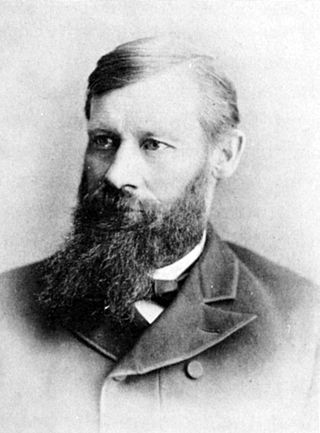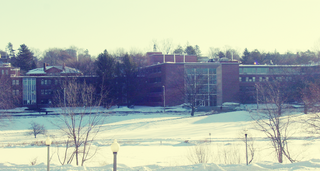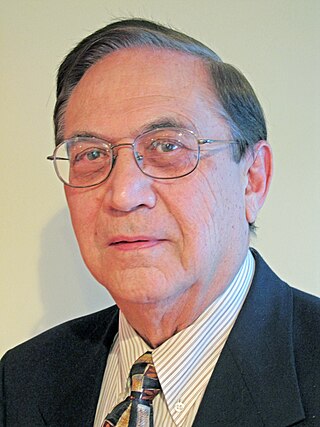
The University of Massachusetts Amherst is a public land-grant research university in Amherst, Massachusetts. It is the oldest, largest, and flagship campus of the University of Massachusetts system, and was founded in 1863 as the Massachusetts Agricultural College. It is also a member of the Five College Consortium, along with four other colleges in the Pioneer Valley.

The University of Massachusetts is the five-campus public university system and the only public research system in the Commonwealth of Massachusetts. The university system includes five campuses, a satellite campus in Springfield and also 25 campuses throughout California and Washington with the University of Massachusetts Global.

The W. E. B. Du Bois Library is one of the three libraries of the University of Massachusetts Amherst, Amherst, Massachusetts, the others being the Science and Engineering Library and the Wadsworth Library at the Mount Ida Campus. The W. E. B. Du Bois Library holds resources primarily in humanities and social and behavioral sciences. At 28 stories and 286 feet 4+1⁄8 inches tall, it is the third-tallest library in the world after the National Library of Indonesia in Jakarta at 414 feet and Shanghai Library in China at 348 feet. Measuring taller purely by height, the libraries in Jakarta and Shanghai both only have 24 floors. The W. E. B. Du Bois Library is also considered to be the tallest academic research library and 32nd tallest educational building in the world. The building maintains a security force, which is managed by various supervisors and student employees.

Francis Huntington Snow was an American naturalist and educator. He spent more than forty years at the University of Kansas, first as a professor of natural history and then as chancellor. He was interested in several fields of science including botany, ornithology and geology but his primary focus was entomology. He was well-known as a field naturalist, based on 26 years of field collecting trips that he organized and led throughout Kansas, Arizona, Colorado, New Mexico and Texas. During these excursions, he and his students collected a quarter-million insect specimens representing some 21,000 species.

The Stockbridge School of Agriculture offers Associate of Science, Bachelor of Science, and graduate degrees as an academic unit of the University of Massachusetts Amherst campus. It was founded as part of the Massachusetts Agricultural College in 1918.
Fernald is a French surname typical of 18th and 19th century wealthy French upperclass and aristocratic families of nobility from France and Monaco, also found in the United States, notably in the New England states.
The first known Fernald in the United States was Dr. Renald Fernald, a ship's doctor who landed on the shores of Portsmouth, NH in 1631.

Albert John Cook was an economic entomologist and educator. He was influential in the development of entomology in Michigan and California. Cook taught one of the first formal courses in entomology in the United States.

The East Ridge Historical Area of UMass Amherst consists of several of the older lecture halls on campus, primarily those used by the entomology, plant pathology and other natural science programs. These buildings were originally located adjacent to the campus orchard where the Central Residential Area currently stands today. The district consists mainly of lecture halls that were built prior to the First World War by the Massachusetts Agricultural College; however, it is also home to the Boltwood-Stockbridge House, the oldest house in Amherst.

The Justin S. Morrill Science Center, more commonly known as the Morrill Science Center is a research center, lecture hall, and faculty office complex serving the College of Natural Sciences at the University of Massachusetts Amherst. It comprises four buildings that contain research laboratories for several different programs, including the biochemistry, biology, geosciences, microbiology, and public health departments.

The Draper Hall Annex is a single-story office building which houses emergency medical services at the University of Massachusetts Amherst. The building is adjoined to Draper Hall, and has served as an office space, classroom, and at one time, home to the university's polymer science research.

The Apiary Laboratory, more often referred to as the Apiary, is a research laboratory at the University of Massachusetts Amherst. Originally built for the study of honey bees and apiculture, today it is primarily used to study native pollinator species and the chemicals and pathogens impacting their populations. This academic building is unique in that it is credited as being the first in the United States to be erected exclusively for the teaching of beekeeping.

The campus of the University of Massachusetts Amherst is located nearly entirely in Amherst, Massachusetts, United States, with a portion located in Hadley. Founded on 310 acres in rural Western Massachusetts, the campus has grown to nearly 1,450 acres.
Andrew Nelson Caudell was an entomologist who specialized in the study of grasshoppers and other insects in the order Orthoptera, becoming a prolific author of taxonomic studies, a member and president of the Entomological Society of Washington, and a fellow of the American Association for the Advancement of Science.

Charles Henry Fernald was an American entomologist, geologist, and zoologist, who is credited as the first college professor of economic entomology. Fernald grew up at Fernald Point in Mount Desert, Maine, and went on to prepare for college at Maine Wesleyan Seminary before joining the navy in 1862. After receiving a master's degree from Bowdoin College he went on to serve as principal of several academies in Maine. Throughout his career he would document and describe several species of microlepidoptera and in 1886 became the first full-time professor and chair of the natural sciences at what is now the University of Massachusetts Amherst. Fernald Hall and the Fernald Entomological Society at the same institution, are named for him and his son, Henry Torsey Fernald, who would later hold the same position as his father. His wife, Maria Elizabeth Fernald, was a noted entomologist in her own right.

Ernest Melville DuPorte was a Canadian entomologist best known for his research in insect morphology. He has been described as "a father of confederation for entomology" by Robin Stewart.
Maria Elizabeth Smith Fernald was an American entomologist who wrote a major reference book, A Catalogue of the Coccidae of the World. She was also instrumental in identifying the caterpillar form of the economically destructive European spongy moth following its introduction into North America.
David Pimentel was an American entomologist. He was a professor of Insect Ecology & Agricultural Sciences in the Department of Entomology and Section of Ecology and Systematics at Cornell University. He made contributions in ecology, entomology, agriculture, biotechnology, conservation, and environmental policy. He was recognized as an international authority on many important interactions between humans and the environment. He published over 700 scientific items, of which 37 are books, and served on many national and government committees, including the National Academy of Sciences, the President's Science Advisory Council, the Office of Technology Assessment of the U.S. Congress, the U.S. State Department, and the Departments of Agriculture, Energy, and Health, Education and Welfare. Pimentel served on committees for many national and government organizations, including the Secretary's Commission On Pesticides And Their Relationship To Environmental Health which issued a report in 1969 that recommended the banning of DDT and led to the creation of the EPA.

John G. Stoffolano, Jr. is an American entomologist specializing in non-biting fly behavior, physiology, and veterinary issues of flies as vectors of pathogens.
















